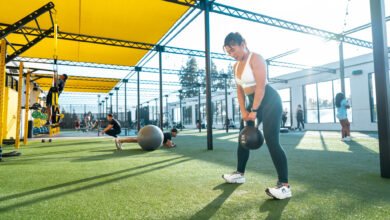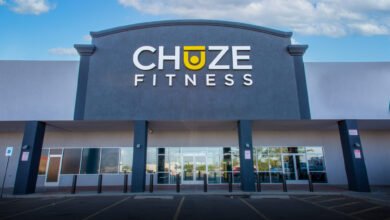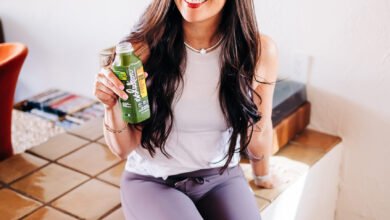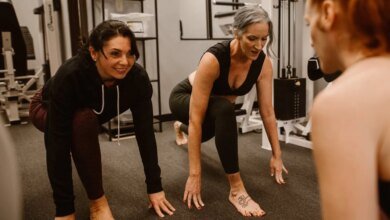Strength Training for Seniors: Stay Active, Strong, & Confident at Any Age
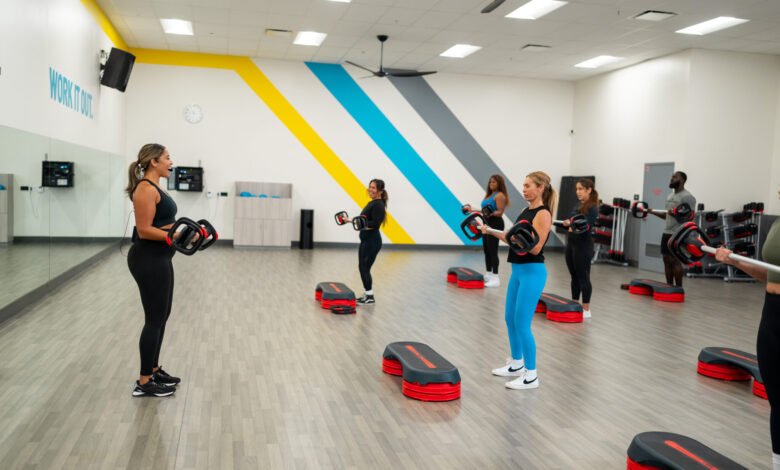
When you hear the phrase “strength training,” you might picture bodybuilders or actors pumping iron, or perhaps a crowd of people in their 20s and 30s doing crunches at the gym.
But strength training isn’t just for the young or the extremely fit. You may not be pressing 40-pound dumbbells over your head (and you don’t have to), but that doesn’t mean you can’t move your body in ways that feel powerful and doable.
Whether you’re new to exercise or have resumed after a long break, it’s never too late to start thinking about strength training for seniors. With a few thoughtful modifications, it can be surprisingly safe and fun — especially with a little guidance from your friends at Chuze Fitness.
Busting common myths about strength training for seniors
One offhand comment or old belief can be enough to make anyone question starting a new fitness routine. But the truth is that strength training is one of the best things you can do for your body as you age.
Let’s set the record straight about some common myths:
- Myth #1: Strength training is dangerous for older people – Sure, poor form or overdoing it can lead to injury, but that’s true at any age. When you train properly, you reduce risks and unlock significant benefits. Strength training helps support balance, bone health, and mobility (all of which are key to aging well).
- Myth 2: Only young people lift weights Staying strong and independent isn’t just for people under 40. Strength training helps maintain muscle mass, supports daily movement, and keeps you doing the things you love, whether that’s gardening, playing with the grandchildren, or traveling.
- Myth 3: You need to lift heavy weights for strength training to be effective – Not at all. You can perform strength exercises using your body weight, resistance bands, or even household items such as water bottles. No fancy equipment needed, just the desire to move your body.
Benefits of strength training for seniors
Strength training may be more important for older adults than it is for younger generations. Why? Because as we age, our bodies naturally lose muscle mass, our posture tends to change, and bone density begins to decrease.
The good news?
Strength training can help slow or even reverse many of these changes, and the mental health perks are a big bonus, too.
Here’s how it helps:
- Improve muscle mass – As we age, our bodies go through a process called sarcopenia – a gradual loss of muscle mass. By consistently strength training, you can build or maintain the muscle fibers you already have.
- Increase bone density After the age of 50, bone density begins to decline, and for women, this decline can accelerate after menopause. Strength training puts enough stress on your bones to activate bone-forming cells, helping them work harder and strengthen your skeleton over time.
- Reduce stress Regular exercise boosts endorphin levels, which are feel-good hormones that help reduce stress and improve mood.
- Building trust -One day, you won’t be sure you can do one squat. Next, you do ten with the solid form. This kind of progress builds real confidence, and reminds you of what your body can still do.
Getting Started Right: What you need to get started
Believe it or not, all you need to start your strength training journey is… You. You can start with bodyweight movements that use your resistance to build strength in a safe, beginner-friendly way. Think: squats, wall push-ups, or even seated leg raises.
When you’re ready to add variety, you can get some simple tools at home or at the gym, like:
- Resistance bands
- Light dumbbells (or water bottles)
- Stable chair
The key is to start where you feel comfortable. Whether you’re lifting with purpose for the first time or returning to exercise after a few years (or decades), strength training can fit you at your level.
Pro Tip: Keep early sessions short but consistent. Starting with just 10 to 20 minutes a few times a week helps you build momentum and, more importantly, a lasting habit.
3 exercises suitable for beginners and seniors
Are you ready to strengthen those muscles, rev up your metabolism, and produce some mood-boosting endorphins? Here are three exercises for seniors you can do no matter where you are on your strength training journey.
#1 Squat chair
Chair squats are a great way to build lower body strength using movements you already do every day: sitting and standing. Chair squats target major muscles, including:
- Thigh muscles
- Hamstrings
- Ass
- Calves
How to perform squats on a chair
We all have that favorite chair that we love to sit in, whether it’s a comfy chair or a cozy place to read. The sit-and-stand motion is already familiar, but strength training turns it into a focused muscle-building movement:
- First step – Stand in front of a sturdy chair with your feet shoulder-width apart and your toes pointed slightly outward.
- Step two – Bend your knees and lower yourself toward the bench, keeping your chest up and your weight on your heels.
- Step three – Press the chair lightly with your glutes – without falling – so that your muscles remain engaged.
- Step four – Push with your heels to return to standing.
Modifications to try
If necessary, here are some modifications you can use to adapt your chair squat to your fitness level:
- Place your hands on your thighs for support or use an armchair to help you get up and down.
- Start with a taller chair or place cushions on the chair seat if a low seat is too challenging.
#2 Wall push-ups
The wall push-up is a modification of the traditional push-up that works some of the major muscle groups in the upper body, including:
- Chest
- shoulders
- Weapons
- The upper and middle part of the back
When done regularly and with proper form, you can improve your posture, arm strength, and your ability to lift objects above your head. What’s not to like?
How to do wall push-ups
All you need is a blank wall, a little space, and an understanding of how to move:
- First step – Stand facing a wall, about two feet away.
- Step two Place your hands flat on the wall at shoulder height and shoulder width apart.
- Step three – Bend your elbows and slowly lower your chest toward the wall.
- Step four – Pause, then press with your hands to return to the starting position.
Modifications to try
Need some modifications to perfect the move? Try these tips:
- Adjust the distance between you and the wall to make movement easier. If you stand close to a wall, you can complete the movement more easily, while standing further away increases the challenge.
- Keep your core active by gently pulling your belly button toward your spine. This helps you avoid arching your back.
#3 The farmer carries light items
From carrying groceries to hauling laundry, life comes with built-in workouts. The farmer’s lift is a simple, full-body move that builds strength where it’s needed, helping you feel strong and confident in your daily routine.
How to perform a farmer’s load
This move strengthens your grip, core, shoulders and legs, all while improving balance and stability.
- First step – Hold a light weight in each hand with your arms relaxed at your sides. A set of light dumbbells or even two full bottles of water work great.
- Step two – Walk slowly and steadily in a straight line for 10 to 20 steps. Focus on keeping your shoulders back and engaging your core.
Modifications to try
If you want more or less challenge with this exercise, try:
- Choose weights that are manageable. You want to challenge yourself, not exhaust yourself. As you build strength, gradually increase the weight.
- Walk next to a wall for extra support (especially if balance is difficult for you).
Sample weekly routine
As the turtle once said: “Slow and steady wins the race.” Strength training may not be the same as a race, but it follows the same principle. With a simple, consistent strength training routine for seniors, you can build strength and confidence over time.
Here’s a weekly approach you can use to mitigate and make progress:
- Day 1: Strength training – Try three to four beginner moves, such as chair squats, wall push-ups, or resistance band rows. Aim for two sets of each.
- Day two: light cardio exercises – Walk or ride a stationary bike for 10 minutes.
- Day 3: Strength training – Repeat the first day’s exercises or swap in new exercises such as farmer’s holds or seated leg extensions.
- Day four: rest – Even if you feel ready for another workout, give your body time to rest. This will help your body recover, allowing you to come back stronger the next workout day.
- Day Five: Balance or flexibility Try chair yoga, tai chi, or basic balance exercises near a wall or chair.
- Day 6: Optional strength exercises or light cardio -Do you feel like doing a short exercise? Repeat your strength training workout or go for a brisk walk.
- Day seven: Rest or light movement – Stretch, find movement with a simple routine or two, or just relax.
How to Exercise Safely (While Building Confidence)
Strength training isn’t about pushing yourself to the limits. It’s about showing up, being toned, and moving in a way that supports your body.
These tips can help you stay safe while boosting your confidence with each rep.
- Warm up first Spend about five minutes preparing your muscles to move. Try alternating between walking in place, arm circles, and gentle side steps to increase circulation and prepare your joints.
- Use support when needed -Walls, sturdy chairs and countertops are great tools to help with balance. Count on them (literally!) as you build strength and stability.
- Ease into gradual overload – This simply means increasing the challenge little by little. You can add extra repetitions, use slightly heavier weights, or reduce your rest time. Small steps lead to big results.
- Modify as needed – Adjust exercises to suit your comfort and ability. Whether you’re downsizing or upping your game, remember: strength looks different for everyone, and you’re where you want to be.
Feel empowered with a little help from Chuze
Whether you’re just starting out or looking for a little extra guidance, you don’t have to do it alone. At Chuze Fitness, our Lift Lab offers training in a friendly, private and exclusive space away from the hustle and bustle of the gym. It’s a great way to learn proper form, stay consistent, and build confidence at your own pace.
We recommend trying a few moves from this guide, then stopping by the Lift Lab to keep up the momentum. There you will find support that meets you wherever you are.
sources:
National Institutes of Health. How can strength training build healthier bodies as we age? https://www.nia.nih.gov/news/how-can-strength-training-build-healthier-bodies-we-age
National Institutes of Health. How can strength training build healthier bodies as we age? https://www.nia.nih.gov/news/how-can-strength-training-build-healthier-bodies-we-age
Johns Hopkins. Osteoporosis: What you need to know as you age. https://www.hopkinsmedicine.org/health/conditions-and-diseases/osteoporosis/osteoporosis-what-you-need-to-know-as-you-age
Harvard Health Publishing. Strength training builds more than muscle. https://www.health.harvard.edu/staying-healthy/strength-training-builds-more-than-muscles
Harvard Health Publishing. Exercise is a natural remedy for fighting depression. https://www.health.harvard.edu/mind-and-mood/exercise-is-an-all-natural-therapy-to-fight-depression
Issa. Squats: muscles worked, form, variations, and more. https://www.issaonline.com/blog/post/the-squat-muscles-worked-form-variations-and-more
Medical news today. What muscles do push-ups work? https://www.medicalnewstoday.com/articles/323640#what-muscles-do-pushups-work
WebMD. What is progressive overload? https://www.webmd.com/fitness-exercise/progressive-overload
 Reviewed by:
Reviewed by:
Annie is the Vice president of Fitness at Chuze Fitness and oversees the group fitness and team training departments. She has had over 25 years working in club management, personal training, group exercise and coach training. Annie lives with her husband and son in San Diego, California, and loves hot yoga, snowboarding, and all things wellness.
Don’t miss more hot News like this! Click here to discover the latest in Health and Fitness news!
2025-08-25 06:16:00

